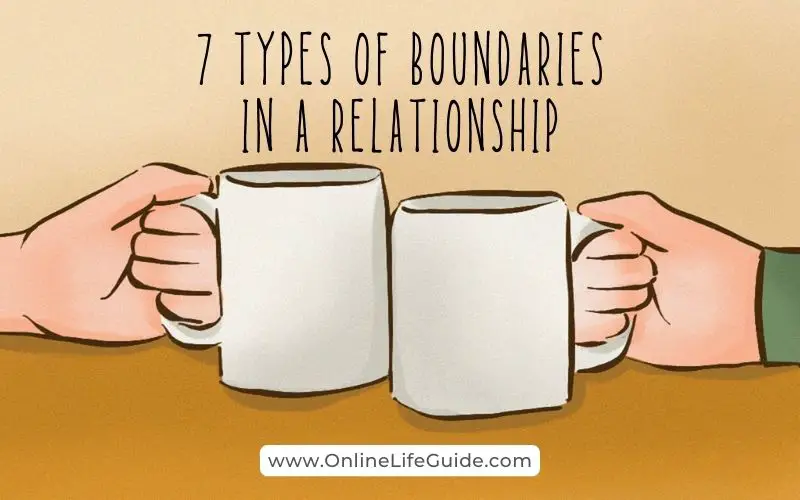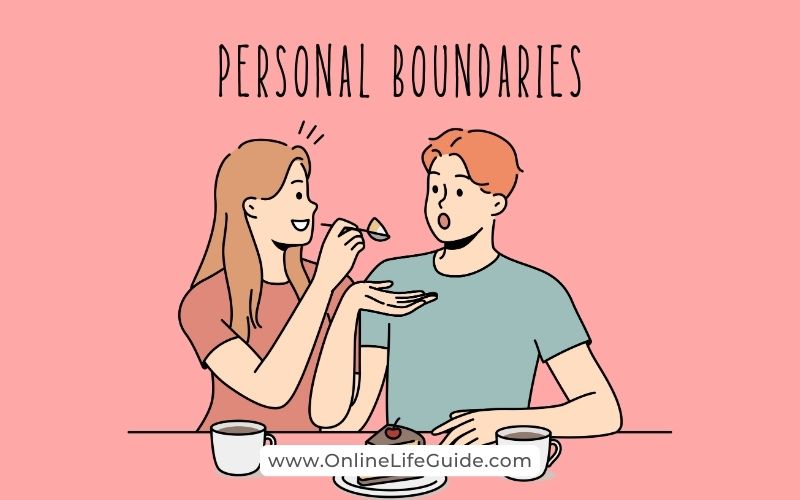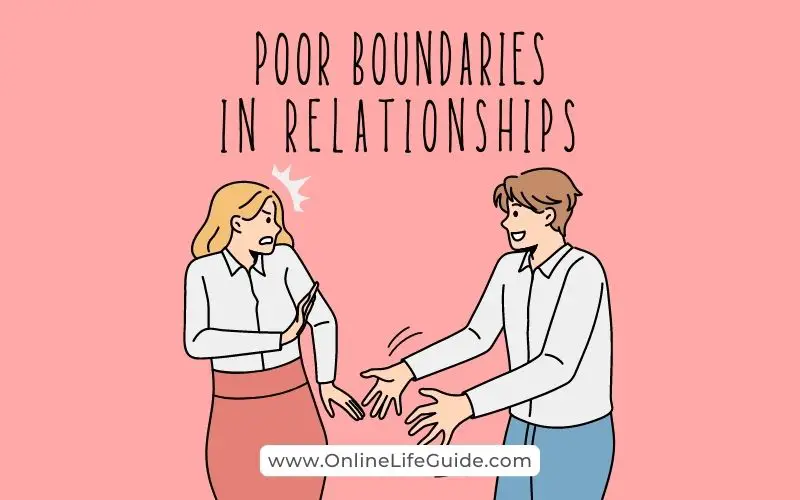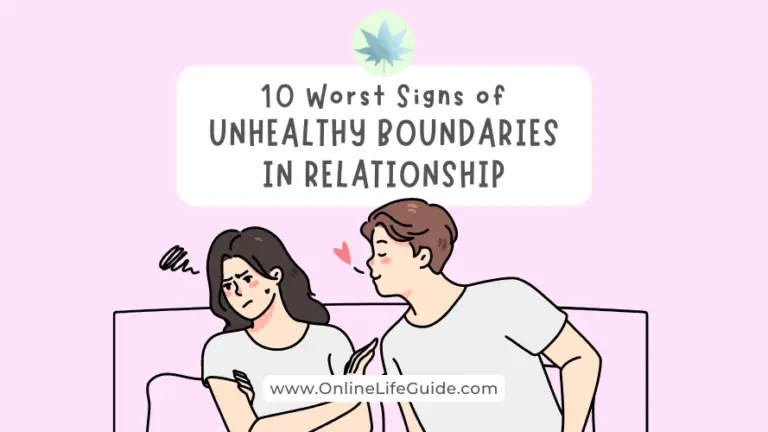7 Types of Boundaries in Relationships – With Real Examples

To practically understand the different types of boundaries in a relationship, let’s look into the life of Sarah and Abraham who are married for over a decade and have nearly mastered the art of setting healthy boundaries in their relationship.
Their open and honest communication about each other’s wants, needs, and expectations, and their respect for each other’s personal space and individuality have allowed them to grow as individuals as well as have a flourishing and fulfilling relationship.
Having set boundaries with regard to their personal time allows them to have some time by themselves to relax and recharge even after having demanding careers.
Abraham, for example, values spending some time in solitude without any interruptions after coming home from work, which he gently but clearly communicated to Sarah.
She respected his need for space, understood his boundaries, and never took it personally.
On the other hand, Sarah valued quality time together and needed physical and verbal gestures of affection after a long day.
So Abraham made sure to show affection through hugs, words of reassurance, and through active listening after he recharged his own mental and emotional batteries.

Sarah trusted him and knew he would give her time when he had relaxed and winded down a bit.
They never took each other’s time, attention, and care for granted, and would be considerate towards each other when one was tired or having a rough day.
Even though they had a very close bond, there was a sense of personal privacy. They didn’t randomly go through each other’s phones or logged into each other’s social media accounts.
Each of them has dedicated a day of the week for themselves, which they spend indulging in self-care activities without any guilt.
One of the most important boundaries they established were emotional boundaries. With time, experience, and consistent effort they learned how to process their feelings and convey them to each other effectively.
Sarah and Abraham were aware of each other’s mental and emotional triggers and were mindful of how their behaviors and words might impact the other person.
If they had to have a discussion on a difficult and sensitive topic, they would do so in a civil and composed manner, never letting the discussion or argument go out of control to the point where it could affect their relationship.
They committedly promised themselves to never use each other’s emotions, pain points, and weaknesses against each other and never ever weaponize each other’s secrets and vulnerabilities.
Nor do they ever use physical intimacy to control or manipulate each other.
As for physical intimacy, they mutually agreed to only engage in intimate activities that felt comfortable for both of them.
Now, not everything is picture-perfect, sunshine and rainbows in their relationship.
They go through disagreements and arguments like any other couple, but the boundaries and the dynamic they’ve set in their relationship enable them to handle such situations effectively.
Small frictions and disagreements don’t stand in the way of their healthy relationship because they have their boundaries in place, which they have consciously and intentionally worked to establish so that they could not only have stability in their relationship but also have mental and emotional wellness as a result.
What are Healthy Boundaries?

You might have picked up on a lot of boundaries in Abraham and Sarah’s marriage, but if we were to go into specifics, what defines good boundaries, and what types of boundaries should a couple focus on?
Boundaries, in general, are the rules or limits of every individual that define the person’s sense of identity, personal choice, and personal space in different aspects of life. Boundaries define what are and aren’t acceptable behaviors within a relationship.
Boundaries might vary from person to person, so it’s important to communicate your boundaries as well as be mindful of the boundaries of the other person.
Having good Emotional Intelligence helps pick up on the hints and cues of the other person while also understanding their limits and expectations.
When healthy boundaries are established in a relationship, they serve as a guide for how both people will interact with each other in a way that establishes a sense of respect, emotional independence, and deep trust.
Clear and well-defined boundaries equip both partners to swiftly navigate the complexities of their relationship and avoid conflicts, misunderstandings, and resentment, leading to a meaningful and deeply fulfilling bond.
7 Types of Boundaries in Relationships

So what are some good relationship boundaries?
What are some examples of healthy boundaries in marriage?
To help you compartmentalize and bring you further clarity in terms of setting boundaries in different aspects of life, let’s break them down into 7 categories.
These 7 types of Boundaries encompass most of our mental, physical, and emotional needs:
- Personal Boundaries
- Emotional Boundaries
- Mental/Intellectual Boundaries
- Material & Financial Boundaries
- Time Boundaries
- Physical/S * x u a l Boundaries
- Digital Boundaries
Let’s look into each of them with practical examples of what each type of boundary would look like in real life.
Personal Boundaries

Generally, all boundaries are personal so to say but what we are talking about here are boundaries that include your personal choices, your general likings, and dislikings, your personal space, and privacy.
Everyone must have the freedom to personally like and dislike whatever they want, and it’s their right that their personal choices be respected if they’re not harmful to them or others, or negatively affecting someone else.
If you find yourself or your partner ridiculing or criticizing each other’s personal choices too often, you might need to set some personal boundaries to maintain respect in the relationship.
Setting boundaries around personal space and privacy can be a bit tricky in intimate relationships and you’ll have to figure out what works best for you according to the dynamics of your particular relationship.
In the long run, having some boundaries around personal space and privacy can help avoid clinginess, toxic attachment, and controlling behaviors.
Being able to spend some time apart to reconnect with yourself and with others in your life (friends, relatives, etc) is crucial for a healthy marriage.
As much as it is important to spend lots of quality time with your partner, you shouldn’t feel trapped to always do things together or spend all of your spare time with your partner.
Examples of Personal Boundaries
- Respecting each other’s dressing style. If one partner is uncomfortable with the dressing of the other, then having gentle communication about it.
- Giving space to each other when needed.
- Freedom to go out with friends or have some “me-time”.
- Not looking into each other’s personal diaries.
- Not asking too many nosy questions regarding the conversation your partner had with someone.
- Allowing each other space to have personal hobbies, interests, and entertaining activities without the involvement of the other partner.
Emotional Boundaries

Setting emotional boundaries means that you are emotionally independent of your partner and that you don’t feel guilty about taking care of yourself and drawing boundaries in other areas of the relationship where needed.
Emotional boundaries also mean that you don’t expect each other to feel the exact same way regarding certain things, while at the same time respecting each other’s emotions and emotional needs.
Statements like “you shouldn’t feel that way” might indicate that the person is not really respecting and accepting how the other person feels.
Also, having too many expectations from your partner, and being upset and resentful when they don’t meet those exact expectations means there is a lack of emotional boundaries.
On the other hand, always feeling responsible if your partner is not in a good mood and taking the burden of their moods on yourself also indicates a lack of boundaries.
When there are healthy emotional boundaries in a relationship, both partners feel safe and comfortable. There is a deep sense of trust and reliability (there is a difference between dependency and reliability).
Here are a few examples of good emotional boundaries:
Examples of Emotional Boundaries
- Both partners take responsibility for their moods and do not put blame on each other.
- Respecting the other person’s emotional state even if you aren’t feeling the same.
- Knowing that you both don’t always have to feel the same about things.
- None of you should try to make each other feel guilty or bad about yourself.
- There is no anxiety or fear of each other’s reactions to everyday little things.
- There is no “I will do ANYTHING to make you happy” kind of thing in a healthy and well-balanced relationship that has good emotional boundaries.
- No emotional blackmailing, direct or indirect, of any kind.
- Your sense of identity doesn’t revolve solely around your relationship and your role as a spouse.
- Good communication in a healthy and civilized way regarding the things that might be bothering one of you or making you feel uncomfortable.
Intellectual Boundaries

Being in the age of information has made us intellectually more complex, aware, and opinionated than ever before. There is a good probability that your partner differs from you on several intellectual grounds.
Whether it be political preferences, philosophical differences, professional choices, or differences in the way you both view certain things, know that no matter how close we are to someone, by the end of the day, they are a different person with varying perspectives and world views.
Downplaying someone’s views and opinions and thinking of yourself as intellectually better than the other person is a violation of the other person’s intellectual boundaries.
Examples of Intellectual Boundaries
- Being able to have intellectual discussions and debates in a respectful manner.
- Listening to each other’s views with the intent of understanding and being open to considering it rather than rejecting it immediately.
- Not constantly taunting or criticizing each other’s choices and opinions.
- Being okay with having some differences. Understanding that you both don’t have to have similar views regarding everything.
- Not taking intellectual differences personally.
- No urge to prove the other person wrong and say “see, I was right and you were wrong”.
Material & Financial Boundaries

There must be clear boundaries regarding how the couple will manage their finances. Whether both will contribute an equal share or one takes full charge of the financial responsibility of their home.
Boundaries regarding how both of you will spend the money, how much you save, how you plan your family finances, and if there will be separate bank accounts or a joint account.
Also, in terms of material possessions, it’s better to have clearly communicated boundaries regarding what you are willing to share and what is too personal for you to share don’t feel comfortable sharing.
If both of you have separate cars, your partner might not be comfortable with you taking their car without their permission.
Examples of Financial Boundaries
- Having clarity about how you’ll manage finances as a couple and who is contributing what.
- Clear boundaries regarding how much you’ll spend and how much you’ll save up each month.
- Letting each other know if they have to spend extra on something (that is, if you both have agreed to set certain financial goals and expenditure boundaries for the family, and are contributing together towards it).
- Respecting each other’s possessions and not using them or throwing them away without permission.
- Not messing up each other’s organized stuff or relocating them without consent.
- Being considerate of each other’s belongings.
Time-Related Boundaries

It’s pretty common to take our partner’s time for granted and expect them to be available to us 24/7.
Assuming that your partner is free for you at any given moment and interrupting them for your needs when they are busy with something can be quite annoying, leading to resentment and loss of respect in the relationship.
Examples of Time-Related Boundaries
- Being respectful of each other’s time and asking when they’ll be free to talk or take time out for something.
- Being considerate and understanding when the other person is busy and in the midst of something important.
- Not making spontaneous plans that might disturb the other person’s schedule without proper communication.
- Not inviting guests over without communicating with each other first.
- Valuing each other’s “me-time” and understanding that you both might need some time off from each other to recharge and reconnect with yourself.
Physical / S * x u a l Boundaries in a Relationship

It’s essential to have healthy communication when it comes to this. Respecting your partner’s feelings and needs, likes and dislikes regarding physical intimacy, as well as communicating your own preferences is crucial for mutual fulfillment when it comes to this aspect of the relationship.
Be considerate and mindful of each other. Notice the hints and signals of liking and dislikings in your partner. It’s common to miss out on subtle unspoken signals.
Make sure you both are fulfilled with the physical aspect of the relationship. If there’s a lack of fulfillment or if something is bothering you, you need to communicate it properly.
Since men and women are mentally and biologically different, their physical needs can vary greatly at times. It’s important to respect differences and create balance and harmony.
Understanding each other likings and dislikings in this area is monumental to keeping the spark alive in a relationship in the long run.
Examples of S * x u a l Boundaries
- Mutual consent is a must.
- Both feel safe, heard, and understood.
- Open and ongoing communication regarding preferences, desires, likes, dislikes, do’s, and don’t.
- No shaming each other about particular preferences.
- Making sure there is mutual fulfillment.
- Not discussing your bedroom experiences with anyone else (unless there is a particular purpose, such as in the case of consulting a therapist)
Digital Boundaries

In this growing age of technology, it has become a necessity not just for a healthy relationship but also for one’s mental health to draw some really good boundaries around digital devices.
A lot of people set decent boundaries in other areas but never take digital limits into consideration because they see them as harmless.
What’s wrong with going through your partner’s phone and messages randomly?
Or what is wrong with taking a picture of your partner without them knowing and posting it online right?
What’s wrong with sharing every detail of how your partner prepped for your birthday and how lucky you are to have her/him?
It would take an entirely separate guide to explain all that is wrong with these kinds of behaviors from a psychological standpoint and how it’s negatively affecting your relationship and your mental well-being.
You might be wondering then, what digital boundaries you should set. Here are a few practical examples:
Examples of Digital Boundaries
- Honoring each other’s digital privacy. Refraining from looking into each other’s phones and social media accounts without permission.
- Clear limit on the time spent on digital devices. Not letting your unstoppable WhatsApp messages or interesting Twitter notifications distract you from having quality time with your spouse. For example, setting a rule to put phones away completely during dinner and movie nights.
- Setting specific times for responding to calls and messages.
- Establishing mutual agreement on what is and isn’t appropriate to post online.
- Not sharing each other’s personal information on social media or with friends without consent.
Poor Boundaries in Relationships

Being complacent or just being unable to establish clear, situation-appropriate, and healthy limitations in the said areas of life can put a strain on the relationship as the years go by.
Poor boundaries often lead to an unhealthy dynamic where one person may feel like giving a lot more and getting a lot less in return. They may also feel like they’re being taken advantage of.
As you can guess (or have experienced) that this type of relationship dynamic can be emotionally draining and overwhelming for one or both partners.
People with poor boundaries in relationships usually experience constant feelings of hurt, confusion, and resentment toward their partner. This is not a very good sign if you want a rich and fulfilling relationship with your spouse.
How to Set Healthy Boundaries in a Relationship

The key to being successful at setting good boundaries is respecting yourself, your time, and your personal space, while also showing respect toward your partner’s boundaries.
A pinch of assertiveness is also required to stand up for your boundaries where needed and to maintain them along the way.
The foundation of setting most boundaries is simply the ability to say ‘NO’. You cannot set clear boundaries if you can’t stand by them and say No when they’re about to be crossed.
The people-pleaser within us often gets in the way of boundary setting. Whenever you’re afraid that your partner might not like it when you draw certain boundaries, remind yourself that it’s for the better.
If you don’t set clear boundaries now, it might negatively affect your relationship in the long run and you can end up hurting your partner and your relationship a lot more.
Setting boundaries is not rocket science at all, but it requires deliberate and consistent action. We’ll break it down into 7 actionable steps:
In another guide, I have explained these 7 steps and MUCH more about setting good boundaries and maintaining them in great detail.
- Know your boundaries.
- Communicate your boundaries effectively.
- Communicate the consequence and effects of violating boundaries on your relationship.
- Repeat steps 2 and 3 to reinforce boundaries until they are well-established.
- Don’t slack on your boundaries. Stick to them firmly.
- Make sure to also respect your partner’s boundaries.
- Set boundaries as early as possible. Don’t procrastinate.
You find the full in-depth guide on exactly How to Set Healthy Boundaries in Your Relationship HERE.
Hope this guide served you well. See you in the next one!








